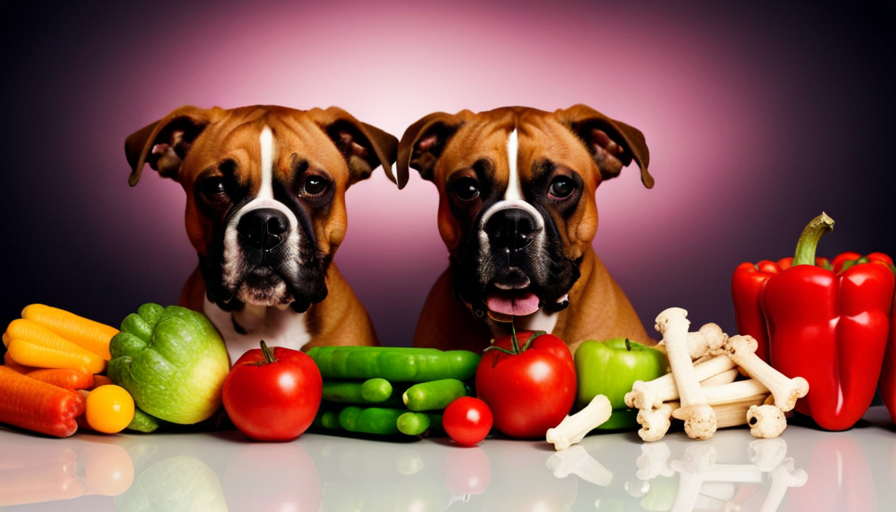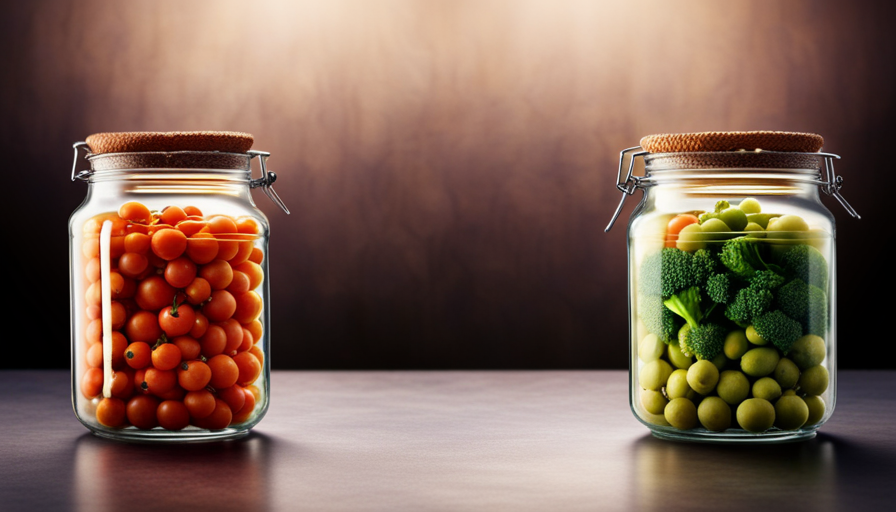Imagine your faithful boxer, consistently eager for a round of fetch or a stroll in the park. However, you’ve recently observed some stiffness in their movements, sparking concern for their joint health. Similar to humans, dogs can also face joint problems, and one successful method to improve their mobility is by including glucosamine in their diet.
Glucosamine is a natural compound that promotes healthy joints and cartilage. If you’re feeding your boxer a raw food diet, you may be wondering how to incorporate this beneficial supplement. Luckily, there are several natural sources of glucosamine that can be easily added to your dog’s meals. From shellfish like shrimp and crab to nutrient-rich bone broth, these options provide your boxer with the necessary nutrients for joint health.
Additionally, there are supplements available that can further boost glucosamine levels. However, it’s important to consult with a veterinarian to determine the right dosage and ensure a balanced diet. By prioritizing your boxer’s joint health and making informed choices, you can help them maintain their active and playful lifestyle for years to come.
Key Takeaways
- Glucosamine is beneficial for a boxer’s joint health and can be added to their raw food diet.
- Natural sources of glucosamine include shellfish like shrimp and crab, bone broth, and certain fruits and vegetables.
- Including glucosamine in a boxer’s diet can help reduce inflammation, improve joint mobility, and enhance joint lubrication.
- It is important to consult with a veterinarian to determine the appropriate dosage and form of glucosamine, as well as to receive personalized recommendations for the boxer’s joint health.
Understanding Joint Health in Boxers
If you want your beloved boxer to stay active and pain-free, it’s crucial to understand the importance of joint health. Boxers are known for their agility and athleticism, but their joints can be prone to injuries and arthritis as they age.
Understanding joint injuries and managing arthritis symptoms are key to ensuring your boxer’s overall well-being. Joint injuries in boxers can occur due to various reasons, such as overexertion, repetitive strain, or trauma. It’s essential to recognize the signs of a joint injury, such as limping, swelling, or stiffness. Early intervention and appropriate treatment can prevent further damage and promote faster recovery.
Arthritis is another common issue that affects boxers’ joint health. As they age, the wear and tear on their joints can lead to inflammation and pain. To manage arthritis symptoms, many boxer owners turn to glucosamine supplements. Glucosamine is a naturally occurring compound that helps maintain the health of cartilage, which cushions the joints. It can alleviate pain, reduce inflammation, and improve joint mobility.
In addition to glucosamine supplements, you can also support your boxer’s joint health through a balanced diet. Incorporate foods rich in omega-3 fatty acids, such as fish and flaxseed, as they have anti-inflammatory properties. Additionally, providing a raw food diet can supply essential nutrients for joint health, such as vitamin C, vitamin D, and antioxidants.
By understanding joint injuries and managing arthritis symptoms, you can help your boxer maintain optimal joint health and enjoy an active, pain-free life.
The Benefits of Glucosamine for Dogs
The benefits of glucosamine for dogs can provide a noticeable improvement in their mobility and joint health. Here are three reasons why including glucosamine in your boxer’s raw food diet can be beneficial:
-
Joint Health Support: Glucosamine is a natural compound that helps to maintain and repair cartilage in the joints. By adding glucosamine to your dog’s diet, you can provide extra support for their joint health. This can be particularly important for boxers, as they’re prone to joint issues like hip dysplasia and arthritis.
-
Reduces Joint Inflammation: Glucosamine has anti-inflammatory properties that can help reduce joint inflammation and pain. By including it in your boxer’s diet, you can alleviate discomfort and improve their overall mobility.
-
Enhances Joint Lubrication: Glucosamine plays a vital role in the production of synovial fluid, which acts as a lubricant for the joints. By increasing the production of this fluid, glucosamine can help reduce friction and promote smoother joint movements.
By incorporating glucosamine into your boxer’s raw food diet, you can provide them with the necessary support for their joint health. However, it’s important to consult with your veterinarian to determine the appropriate dosage and ensure it’s suitable for your dog’s specific needs.
Natural Sources of Glucosamine for Raw Food Diets
You can incorporate natural sources of glucosamine into your boxer’s diet to support their joint health, such as shellfish, bone broth, and certain fruits and vegetables.
Did you know that shellfish, like shrimp and crab, are particularly rich in glucosamine, providing up to 1,500 mg per 3-ounce serving? Including shellfish in your boxer’s raw food diet can be a great way to ensure they’re getting enough glucosamine.
Bone broth is another excellent natural source of glucosamine. It’s made by simmering animal bones and connective tissue, which releases essential nutrients like glucosamine into the broth. You can easily make bone broth at home by simmering bones in water for several hours. It can be added to your boxer’s raw food diet or served as a standalone supplement.
Certain fruits and vegetables also contain glucosamine and can be added to your boxer’s raw food diet. Examples include sweet potatoes, carrots, and green leafy vegetables like spinach and kale. These foods not only provide glucosamine but also offer a range of other essential nutrients for your dog’s overall health.
Incorporating these natural sources of glucosamine into your boxer’s raw food diet can help support their joint health and overall well-being. Remember to consult with your veterinarian to make sure you’re meeting your boxer’s specific dietary needs.
Incorporating Shellfish into Your Boxer’s Meals
Including shellfish in your boxer’s meals can be a delicious and nutritious way to support their joint health and overall well-being. Shellfish, such as shrimp, crab, and lobster, are excellent sources of glucosamine, which is a natural compound that helps maintain healthy cartilage and joints.
If you’re looking for alternative sources of glucosamine for your boxer’s raw food diet, incorporating seafood is a great option.
When incorporating shellfish into your boxer’s raw food meals, it’s important to ensure that the shellfish is fresh and properly prepared. You can steam or boil the shellfish to remove any potential bacteria or parasites before adding it to your boxer’s meal. It’s also important to remove the shell and any sharp or hard parts that could pose a choking hazard.
To incorporate shellfish into your boxer’s meals, you can chop or mince the shellfish and mix it with the other ingredients in their raw food diet. You can also add whole pieces of shellfish as a treat or a special addition to their meal. Just make sure to adjust the portion size accordingly to maintain a balanced diet.
Incorporating shellfish into your boxer’s raw food diet can provide them with an alternative source of glucosamine to support their joint health. Just remember to properly prepare the shellfish and adjust the portion size to ensure a nutritious and balanced meal for your furry friend.
Exploring Bone Broth as a Nutrient-Rich Option
Sipping on a warm cup of bone broth is like wrapping your taste buds in a cozy blanket on a chilly winter day. Not only is it comforting and delicious, but bone broth also offers a range of benefits for your boxer’s joint health.
-
Collagen boost: Bone broth is rich in collagen, a protein that forms the building blocks of connective tissues, including joints. By incorporating bone broth into your boxer’s raw food diet, you can provide them with the necessary nutrients for maintaining healthy joints.
-
Glucosamine alternative: While glucosamine is commonly used to support joint health, bone broth offers an alternative source of this essential compound. Glucosamine helps to maintain the integrity of cartilage and reduce inflammation in the joints.
-
Nutrient-rich option: Bone broth is packed with essential vitamins, minerals, and amino acids that promote overall health and well-being. It contains nutrients like calcium, magnesium, and phosphorus, which are crucial for bone strength and density.
By exploring the collagen benefits of bone broth and incorporating it into your boxer’s meals, you can provide them with an alternative source of joint support. So, go ahead and treat your furry friend to a warm cup of bone broth – their taste buds and joints will thank you!
Adding Organ Meats for Joint Support
Now that we’ve explored the benefits of bone broth for joint support in your boxer’s raw food diet, let’s dive into another nutrient-rich option: organ meats. Adding organ meats to your boxer’s diet can provide a plethora of benefits for their joint health.
Organ meats, such as liver, kidney, and heart, are packed with essential nutrients that can support your boxer’s joints. They’re rich in glucosamine, a natural compound that helps maintain healthy cartilage and reduce inflammation. Glucosamine is a crucial component in the production of glycosaminoglycans, which are necessary for joint lubrication and shock absorption.
Including organ meats in your boxer’s raw food diet can also provide them with a significant amount of vitamins and minerals. Liver, for example, is an excellent source of vitamin A, which plays a crucial role in maintaining healthy joints, as well as vitamin B12, iron, and zinc.
To incorporate organ meats into your boxer’s diet, you can start by introducing small amounts and gradually increasing the portion size. You can either feed the organ meats raw or lightly cook them to ensure their safety. It’s essential to source high-quality, organic organ meats to avoid any potential toxins or contaminants.
By adding organ meats to your boxer’s raw food diet, you’re providing them with a natural and nutrient-dense option for joint support.
Considering Supplements for Additional Glucosamine
Furthermore, it is worth considering supplements to provide an additional source of glucosamine for optimal joint support. While organ meats can be a great natural source of glucosamine, supplements can offer a convenient and consistent dosage. Here are some supplement alternatives to consider for your boxer’s raw food diet:
| Supplement | Dosage Recommendation |
|---|---|
| Glucosamine Sulfate | 20 mg per pound of body weight |
| Glucosamine Hydrochloride | 10-20 mg per pound of body weight |
| Methylsulfonylmethane (MSM) | 50-100 mg per pound of body weight |
| Chondroitin Sulfate | 10 mg per pound of body weight |
| Omega-3 Fatty Acids | 1000-2000 mg per 10 pounds of body weight |
These supplements can help support joint health and reduce inflammation. It is important to consult with your veterinarian to determine the appropriate dosage for your boxer based on their specific needs and condition. Additionally, it is crucial to choose high-quality supplements from reputable brands to ensure efficacy and safety.
While organ meats provide some glucosamine, supplements can offer a reliable and consistent source for optimal joint support. Consider incorporating these supplement alternatives into your boxer’s raw food diet, following the recommended dosages for maximum benefit. Remember to consult with your veterinarian for personalized advice and to choose reputable brands for quality assurance.
Balancing Calcium and Phosphorus in Raw Diets
To maintain proper bone health, it’s essential to achieve a balanced ratio of calcium and phosphorus in your dog’s diet. When feeding a raw food diet to your boxer, it’s important to ensure that you are providing enough calcium and phosphorus in the right proportions.
Calcium-rich ingredients that you can add to your dog’s diet include raw meaty bones like chicken necks, turkey necks, or beef bones. These bones not only provide calcium but also offer a chewing exercise for your boxer. Other calcium-rich options include raw dairy products like yogurt or cottage cheese, as well as vegetables like kale or broccoli.
On the other hand, you need to be cautious about the phosphorus content in your dog’s diet. Some phosphorus-rich ingredients to include in moderation are organ meats like liver or kidney, as well as fish like salmon or sardines. While these foods are beneficial for your dog, excessive phosphorus intake can lead to imbalances and potential health issues.
To ensure a balanced ratio of calcium and phosphorus, it’s crucial to consult with a veterinarian or a canine nutritionist who can guide you in formulating a raw food diet that meets your boxer’s specific needs. They can help you determine the appropriate amounts of calcium and phosphorus to include in your dog’s meals, based on their age, weight, and overall health.
Remember, maintaining a proper balance of these minerals is essential for your boxer’s bone health and overall well-being.
Monitoring Your Boxer’s Joint Health and Mobility
Make sure you’re keeping a close eye on your Boxer’s joint health and mobility to ensure they stay active and pain-free as they age. Regularly monitoring their joint health and mobility is essential for catching any issues early and taking necessary actions to maintain their quality of life. Here are four important aspects to consider when assessing your Boxer’s joint health:
-
Observe their movement: Pay attention to how your Boxer moves and any changes in their gait or posture. Are they limping or favoring a particular leg? These signs could indicate joint problems.
-
Watch for stiffness: Notice if your Boxer has difficulty getting up, climbing stairs, or jumping. Stiffness can be a sign of joint inflammation or arthritis.
-
Check for swelling: Gently feel your Boxer’s joints for any swelling or heat. Swollen joints can be a sign of injury or joint disease.
-
Consult your veterinarian: Regular check-ups with your veterinarian are crucial for monitoring your Boxer’s joint health. They can perform a thorough assessment and provide guidance on appropriate interventions, such as adding glucosamine to their diet.
By actively monitoring your Boxer’s joint health and mobility, you can catch any issues early and take proactive measures to ensure their comfort and well-being as they age.
Consulting with a Veterinarian for Individualized Recommendations
Consulting with a veterinarian can provide personalized recommendations for addressing your Boxer’s joint health and mobility concerns. When it comes to adding glucosamine to your dog’s raw food diet, it’s important to seek professional advice.
A veterinarian can evaluate your Boxer’s specific needs and determine the appropriate dosage and form of glucosamine to include in their diet. During a vet consultation, the veterinarian will take into consideration your Boxer’s age, weight, overall health, and any existing joint issues. They may also recommend additional supplements or dietary changes to support your dog’s joint health. It’s crucial to follow their guidance as they have the expertise and knowledge to tailor a plan specifically for your Boxer.
Additionally, a veterinarian can provide information on the potential benefits and risks of adding glucosamine to your dog’s diet. They can explain how glucosamine works to improve joint health and mobility and whether it’s suitable for your Boxer’s individual situation.
By consulting with a veterinarian, you can ensure that you’re making informed decisions about your Boxer’s diet and taking the necessary steps to support their joint health and mobility. Remember, every dog is different, and personalized recommendations from a veterinarian are essential for optimal results.
Frequently Asked Questions
How often should I give my boxer glucosamine supplements?
To choose the right glucosamine supplement for your boxer, consider factors like dosage, quality, and form (such as liquid or chewable). Look for products specifically formulated for dogs, as their needs may differ from humans.
Additionally, alternative options for glucosamine include natural food sources like shellfish or bone broth, which can be added to your boxer’s raw food diet.
Consult with your veterinarian to determine the best approach for your furry friend’s joint health.
Can I give my boxer glucosamine if they have a seafood allergy?
If your boxer has a seafood allergy, it’s important to find alternatives to glucosamine. Glucosamine is commonly derived from shellfish, so it can trigger an allergic reaction. However, there are other options available. You can consider supplements that contain glucosamine derived from non-seafood sources, such as corn or fungi. Additionally, you can consult with a veterinarian who can recommend alternative joint supplements that can provide similar benefits for your dog.
Are there any side effects of giving my boxer glucosamine?
There are minimal side effects associated with giving your boxer glucosamine. However, if you’re looking for potential alternatives or natural sources of glucosamine for dogs, there are a few options to consider.
Some natural sources of glucosamine for dogs include shellfish, bone broth, and cartilage. Additionally, you can explore supplements that contain other joint-supporting ingredients like chondroitin sulfate or MSM.
It’s always best to consult with your veterinarian before adding any new supplements or ingredients to your dog’s diet.
Can I give my boxer too much glucosamine?
Can you give your boxer too much glucosamine?
While it’s important to provide your dog with the right amount of glucosamine, excessive intake can potentially lead to side effects.
However, glucosamine can also help with other health conditions in your boxer, such as arthritis and joint pain.
If you’re looking for alternative natural supplements for joint health in dogs, options like chondroitin sulfate, MSM, and omega-3 fatty acids can be beneficial.
How long does it take to see the effects of glucosamine on my boxer’s joint health?
To introduce glucosamine into your boxer’s raw food diet, it’s important to consider the effects on joint health and the timeframe for seeing results. Studies suggest that the effects of glucosamine on joint health may vary among individuals and depend on factors such as age and severity of joint issues. Generally, it may take several weeks to a few months to observe significant improvements in joint health after incorporating glucosamine into your boxer’s diet.
Can I Add Glucosamine to My Cat’s Raw Food Diet?
Yes, you can add glucosamine to your feline raw food diet. It’s important to ensure the fats in the diet are balanced to maintain optimal health. Glucosamine can help support your cat’s joint health, especially if they are getting older or have joint issues.
Conclusion
In conclusion, adding glucosamine to your boxer’s raw food diet can greatly benefit their joint health and mobility. By incorporating natural sources such as shellfish and bone broth, you can ensure they’re receiving the necessary nutrients. Additionally, supplements can provide an extra boost of glucosamine.
Remember to balance calcium and phosphorus in their meals to maintain overall health. As the saying goes, "An ounce of prevention is worth a pound of cure." So take proactive steps to support your boxer’s joints and consult with a veterinarian for personalized recommendations.










